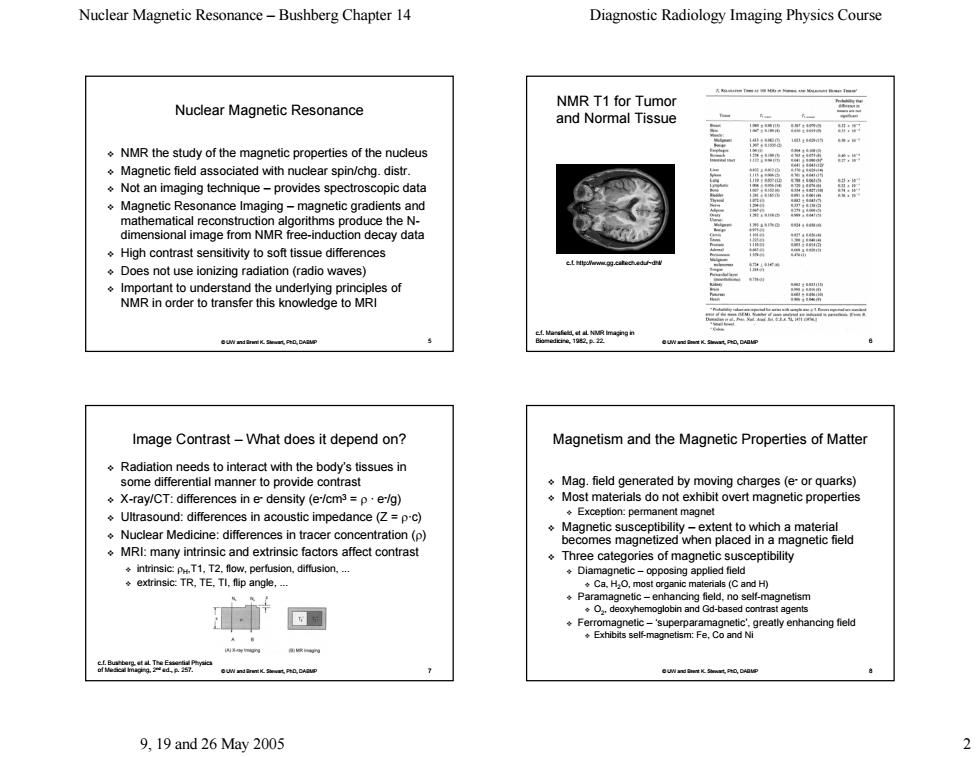正在加载图片...

Nuclear Magnetic Resonance-Bushberg Chapter 14 Diagnostic Radiology Imaging Physics Course NMR T1 for Tumor Nuclear Magnetic Resonance and Normal Tissue NMR the study of the magnetic properties of the nucleus Magnetic field associated with nuclear spin/chg.distr. Not an imaging technique-provides spectroscopic data 润 Magnetic Resonance Imaging-magneticgradients and mathematical reconstruction algorithms produce the N- dimensional image from NMR free-induction decay data High contrast sensitivity to soft tissue differences Does not use ionizing radiation(radio waves) Important to understand the underlying principles of NMR in order to transfer this knowledge to MRI Image Contrast-What does it depend on? Magnetism and the Magnetic Properties of Matte Radiation needs to interact with the body's tissues in some differential manner to provide contrast Mag.field generated by moving charges(e-or quarks) X-ray/CT:differences in e density (e/cm3=pe/g) Most materials do not exhibit overt magnetic properties Ultrasound:differences in acoustic impedance(Z=p-c) ◆Exception:perma hent magnet Nuclear Medicine:differences in tracer concentration(p) Magnetic susceptibility-extent to which a material becomes magnetized when placed in a magnetic field MRI:many intrinsic and extrinsic factors affect contrast Three categories of magnetic susceptibility intrinsic:pT1.T2.flow,perfusion,diffusion,. Diar extrinsic:TR,TE.TI.flip angle, ost organic ma 0gneic aoneanae (Cand) age 4 9,19and26May2005 Nuclear Magnetic Resonance – Bushberg Chapter 14 Diagnostic Radiology Imaging Physics Course 9, 19 and 26 May 2005 2 © UW and Brent K. Stewart, PhD, DABMP 5 Nuclear Magnetic Resonance NMR the study of the magnetic properties of the nucleus Magnetic field associated with nuclear spin/chg. distr. Magnetic field associated with nuclear spin/chg. distr. Not an imaging technique Not an imaging technique – provides spectroscopic data Magnetic Resonance Imaging Magnetic Resonance Imaging – magnetic gradients and magnetic gradients and mathematical reconstruction algorithms produce the Ndimensional image from NMR free-induction decay data High contrast sensitivity to soft tissue differences Does not use ionizing radiation (radio waves) Does not use ionizing radiation (radio waves) Important to understand the underlying principles of Important to understand the underlying principles of NMR in order to transfer this knowledge to MRI NMR in order to transfer this knowledge to MRI © UW and Brent K. Stewart, PhD, DABMP 6 NMR T1 for Tumor NMR T1 for Tumor and Normal Tissue c.f. Mansfield, et al. NMR Imaging in Biomedicine, 1982, p. 22. c.f. http://www.gg.caltech.edu/~dhl/ © UW and Brent K. Stewart, PhD, DABMP 7 Image Contrast Image Contrast – What does it depend on? Radiation needs to interact with the body’s tissues in Radiation needs to interact with the body’s tissues in some differential manner to provide contrast some differential manner to provide contrast X-ray/CT: differences in e- density (e-/cm3 = ρ · e-/g) Ultrasound: differences in acoustic impedance (Z = Ultrasound: differences in acoustic impedance (Z = ρ·c) Nuclear Medicine: differences in tracer concentration ( Nuclear Medicine: differences in tracer concentration (ρ) MRI: many intrinsic and extrinsic factors affect contrast MRI: many intrinsic and extrinsic factors affect contrast intrinsic: intrinsic: ρH,T1, T2, flow, perfusion, diffusion, . ,T1, T2, flow, perfusion, diffusion, . extrinsic: TR, TE, TI, flip angle, . extrinsic: TR, TE, TI, flip angle, . c.f. Bushberg, et al. The Essential Physics of Medical Imaging, 2nd ed., p. 257. © UW and Brent K. Stewart, PhD, DABMP 8 Magnetism and the Magnetic Properties of Matter Magnetism and the Magnetic Properties of Matter Mag. field generated by moving charges (e- or quarks) or quarks) Most materials do not exhibit overt magnetic properties Exception: permanent magnet Exception: permanent magnet Magnetic susceptibility Magnetic susceptibility – extent to which a material extent to which a material becomes magnetized when placed in a magnetic field Three categories of magnetic susceptibility Diamagnetic Diamagnetic – opposing applied field Ca, H2O, most organic O, most organic materials (C and H) materials (C and H) Paramagnetic Paramagnetic – enhancing field, no self enhancing field, no self-magnetism O2, deoxyhemoglobin and Gd-based contrast agents Ferromagnetic Ferromagnetic – ‘superparamagnetic’, greatly enhancing field Exhibits self Exhibits self-magnetism: Fe, Co and Ni magnetism: Fe, Co and Ni